How Do You Compare The Quality Of Solar Lights?

By Michael Zhang || Updated on 5th March 2024
Michael Zhang is a seasoned professional with 15 years of experience in the solar lights industry. Throughout his career, he has been actively involved in product design and developing, gaining valuable expertise and insight into the industry. Known for his dedication and professionalism, Michael has contributed significantly to the growth and success of various solar lights projects. His extensive knowledge and hands-on experience make him a trusted authority in the field, and he continues to innovate and excel in his role.
On various e-commerce platforms, the abundance of solar lamps can be overwhelming, with varying levels of reviews. How can one choose the best-quality solar lights from the multitude of products available? As a supplier of solar garden lights, we will adopt the perspective of the manufacturer, leveraging a genuine understanding of the products. We will guide you through the process of comparing products from different sellers, using two steps and four real cases to help you select the best-quality outdoor solar lights.
Table of Contents
Step 1: Verify the Parameters
Verify the Parameters for Reasonableness to Determine Honest Sellers from Deceptive Ones.
We randomly captured images of four products on the Amazon platform, and we will begin the analysis in the order of these four products.
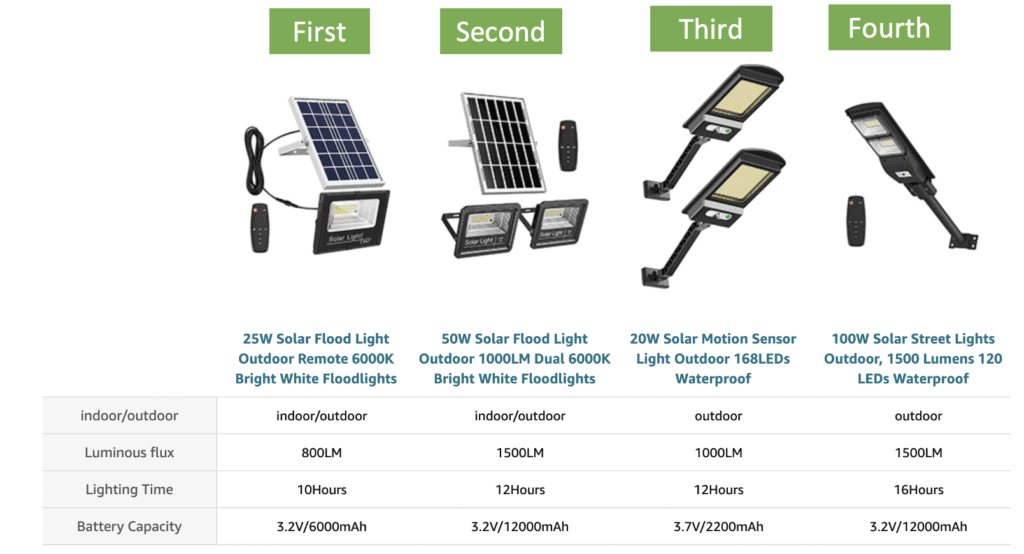
First Product
The seller provides information on parameters like solar panels, lumens, and battery capacity, but LED efficiency is missing. Let’s calculate the following data based on the LED efficiency of 100 lumens per wattage that is commonly used in the industry.
- Lumen: 800lumen
- Battery capacity: 3.2V 6000mAH=19.2WH
- Solar panel: 6V 6W (parameters are found in the product description page as below)
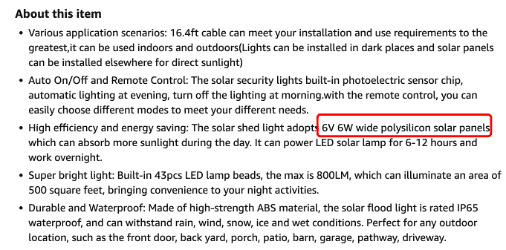
Q1: How long does it take to fully charge the battery?
- 19.2WH/6W*0.8=2.56 hours
Q2: How many hours can the product light up after fully charged?
- Assuming the efficiency of LED is 100lumen per wattage
- LED output=800Lumen/(100lumen/wattage)=8 wattage
- Working time: 19.2WH/8wattage=2.4hours
The adverts for the first product claimed that the parameters were perfect and that everything was good.
Second Product
The seller provides information on parameters like solar panels, lumens, and battery capacity, but LED efficiency is missing. Let’s calculate the following data based on the LED efficiency of 100 lumens per wattage that is commonly used in the industry.
- Lumen: 1500lumen
- Battery capacity: 3.2V 12000mAH=38.4WH
- Solar panel: 6V 13W (parameters are found in the product description page)
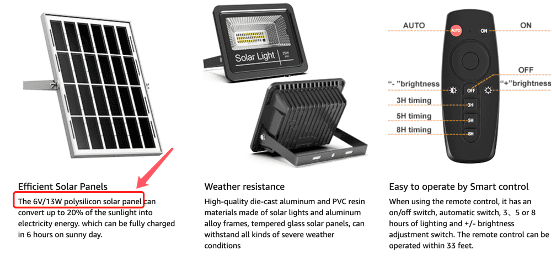
Q1: How long does it take to fully charge the battery?
- 38.4WH/13W*0.8=2.36hrs.
Q2: How many hours can the product light up after fully charged?
- Assuming the efficiency of LED is 100 lumen per wattage
- LED output=1500Lumen/(100lumen/wattage)=15 wattage
- Working time: 38.4WH/15wattage=2.56hours
The advertisement for Product 2 claims its parameters are perfect, everything is so wonderful.
Third Product
The seller provides information on parameters such as solar panels, lumens, and battery capacity, but LED efficiency is also missing. Let’s calculate the following data based on the LED efficiency of 100 lumens per wattage that is commonly used in the industry.
- Lumen: 1000lumen
- Battery capacity: 3.7V 2200mAH=8.14WH
- Solar panel: 6V 3W (parameters are found in the product description page)

Q1: How long does it take to fully charge the battery?
- 8.14WH/3W*0.8=2.17小时
Q2: How many hours can the product light up after fully charged?
- Assuming the efficiency of LED is 100 lumen per wattage
- LED output=1000Lumen/(100lumen/wattage)=10 wattage
- Working time:8.14WH/10wattage=0.814hours
The overall parameter configuration of Product Three is highly unreasonable. If it were to achieve the claimed 1000 lumens, the actual battery life of this solar lamp would only be 0.814 hours. However, the product information states 6 hours, which is clearly false advertising.

Fourth Product
The seller provides information on parameters such as solar panels, lumens, and battery capacity, but LED efficiency is also missing. Let’s assume the industry standard LED efficiency of 100 lumens per wattage.
- Lumens: 1500 lumens
- Battery Capacity: 3.2V 12000mAh = 38.4WH
- Solar Panel: 6V 13W (parameters found on the product description page)
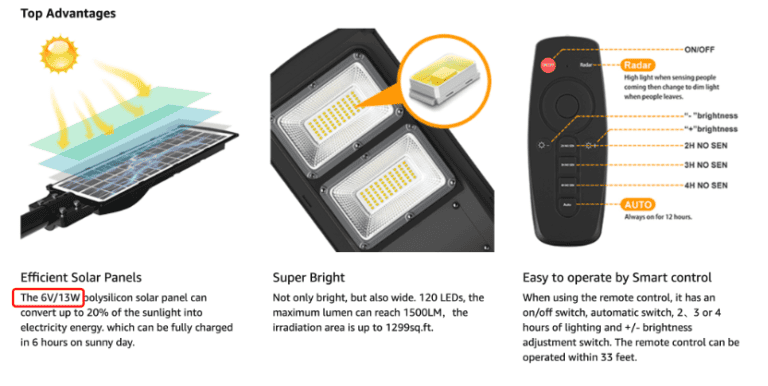
Q1: How long does it take to fully charge the battery?
- 38.4WH/13W*0.8=2.36小时
Q2: How many hours can the product light up after fully charged?
- Assuming the efficiency of LED is 100 lumen per wattage
- LED output=1500Lumen/(100lumen/wattage)=15 wattage
- Working Time:38.4WH/15wattage=2.56hours
Product four is also ok
Eliminate Third Product
After the first round of selection, we eliminate the third product and retain the first, second, and fourth products.
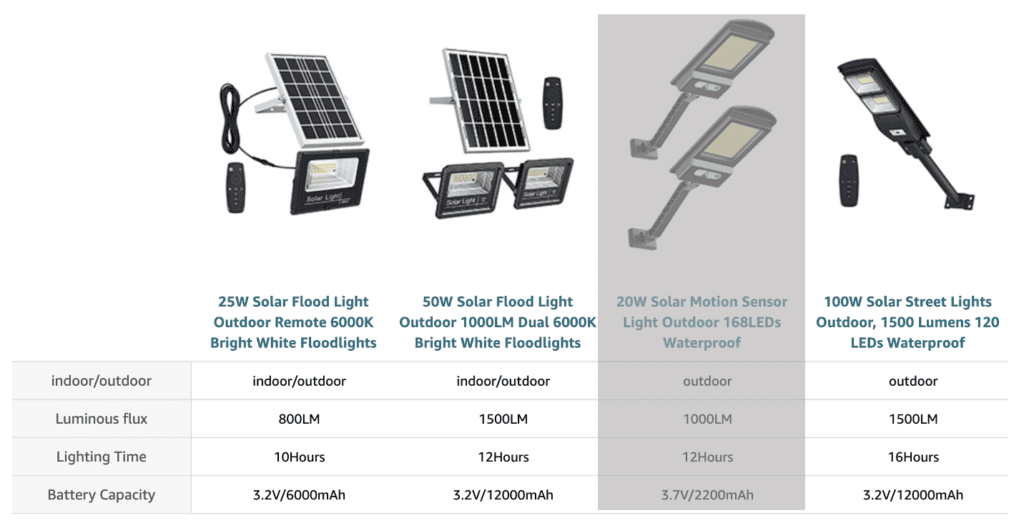
Step 2: Inspect Customer Reviews
Inspect Customer Reviews Rated Three Stars or Below to Identify Quality Issues. Determine which problems with the product are widespread and critical, and which may be isolated incidents.
Next, let’s analyze customer reviews. We will focus on reviews rated three stars or below.
First Product


The main points summarizing the consumer perspectives on purchasing Product Two are as follows:
- The remote control did not function effectively.
- The LEDs on the main lamp did not provide adequate guidance.
- Malfunctioning.
- Product not bright.
- Product only worked for one night.
Among these, points #1 and #2 are related to product design issues, which seem to be widespread problems. Judging from the number of reviews mentioning the product not working, it can be inferred that points #2 and #3 are probabilistic issues.
Second Product
The comments rated three stars or below for the Second product are as follows:





The main points summarizing the consumer perspectives on purchasing Product Two are as follows:
- It takes two days for the solar lamp to fully charge.
- The operation of the remote control is very inconvenient.
- Charged for three days, but the lighting time is only 5-8 hours.
- The product is too small.
- Moisture inside the lamp.
- Out of two products, one worked for one week, and the other worked for five months.
- Water ingress.
- Even with ample sunlight during the day, the lamp cannot sustain continuous operation at night.
- Lumen value is very low.
- Only worked for 4 months.
- Only worked for 5 months.
#1 and #3 are considered critical batch issues. Remember our calculated charging time was only 2.71 hours? But consumers reported charging for 2-3 days. The most likely reason is that the seller overstated the parameters of the solar panel, meaning the actual wattage of the solar panel used in the product must be significantly lower than advertised.
#2 and #4 are product design problems. The seller did not design the product from the user’s perspective, so these are also batch issues.
#5 is a normal problem because there can be condensation due to temperature differences inside and outside the lamp. If the seller added a drainage hole, this problem could be resolved.
#7 Although water ingress is a common phenomenon, if it leads to the product not working, it’s a structural design problem. Due to variations in molds, it’s difficult to conclude whether this is a batch issue or a probabilistic issue.
#8 It’s likely a batch issue, but not necessarily a quality issue. Our calculation showed the product’s working time is only 2.56 hours, meaning consumers should adjust it to a suitable lighting mode. For example, keep it constantly lit for the first two hours, then switch to 0+PIR for the rest of the time. This way, power can be saved while achieving emergency lighting.
#9 It needs further classification based on actual situations. If the brightness remains low throughout the night, it’s a quality issue, perhaps the actual battery capacity is lower than advertised. If the brightness remains high for the first 1-2 hours and gradually dims, it’s a normal phenomenon.
#10 and #11 are critical batch issues. Considering other customer feedback, it’s likely the entire batch of batteries, solar panels, and PCBA from the seller are of poor quality, resulting in abnormally low lifespan. When encountering such products, it’s recommended to avoid them. With this analysis, we can also eliminate the second product now.
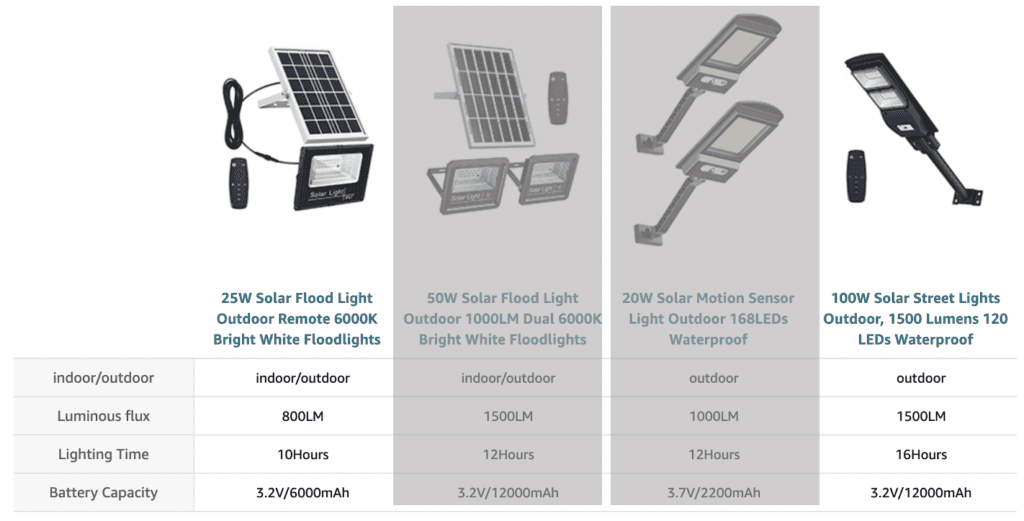
Fourth Product
The comments rated three stars or below for the fourth product are as follows:

- The brightness of the product is insufficient.
- Possibly received a used product.
From the above two feedbacks, there are no apparent issues with the product not working or fatal quality problems.
Conclusion
In conclusion, after eliminating the second and third products, we are left with only the first and fourth products. Since the first product had quality issues, we can prioritize selecting the fourth product.
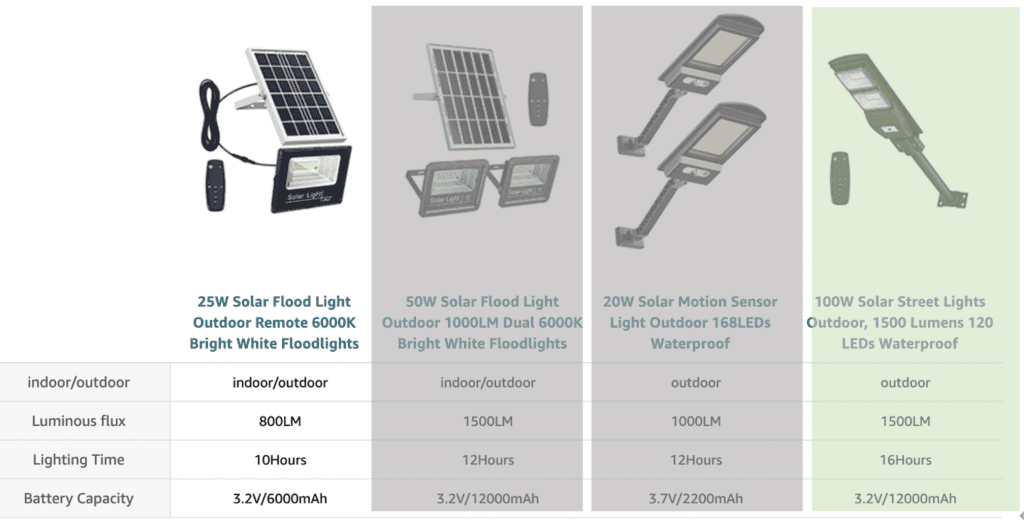
Related Blogs
Share Via:
Get in Touch with Us Now!
Got questions or feedback? We’d love to hear from you! Just fill out the form below, and our friendly team will respond ASAP.
